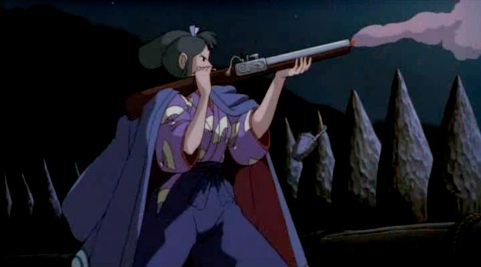Japanese Animation and New Media
Week Twelve: Chapter Twenty: The Spiral Dance of Symptom and Specter
What are the techniques that position men as subjects and women as objects in Mulvey’s account of Hollywood cinema?
Mulvey notes that the viewing position is mostly associated with male characters. This happens in two ways. One, the camera’s viewing position becomes linked to male characters by positioning the camera more frequently behind or alongside them, implying that they are the ones looking. Two, a shot of a woman is preceded or followed by a shot of a man looking. The result is an association of objective shots with women, and subjective shots with men.
In effect, this use of cameras and kinds of shots is a special case of what we previously called cinematism. It is a variation on ballistic perception in which the camera is like a gun (a projectile technology) and the woman is the target. In fact, Mulvey argues that this arrangement is an extension of the Cartesianism implicit in the movie camera. While I don’t share her sense of technological determinism, what is interesting is how she adds questions about gender to cinematism. She argues that male characters will be aligned with the mobile camera and thus with active movement and agency (what we called movement into depth), while female characters will be immobilized in various ways, providing a point of reference or frame of reference for cinematic movement.
Mulvey thinks of such immobilization in terms of objectification. She calls attention to how female characters in some Hollywood films are lavishly costumed, sometimes to the point that they verge on appearing inseparable from the background, from luxurious decors. In other films, in which women are more mobile and active, they tend to be tracked down and punished for their violation of the general law associating the mobile camera and subjective agency with men.
Now there are lots of objections to Mulvey’s account as well as refinements of it. For our purposes, her claims are too big and deterministic. But what is useful is her identification of a very real tendency within cinema and animation — a tendency in which cinematism becomes gendered.
This insight takes us back to Miyazaki’s animations. Recall how, in Princess Mononoke, cinematism was associated with ballistic technologies of war (arrows, bullets), but guns in particular were associated with a woman, Lady Eboshi. Another example is Kushana in Nausicaa. Miyazaki suggests that women with guns present an opportunity for him to shift our perceptions and expectations of action. Yet such a gesture only works if we expect men to be associated with ballistic weaponry. In other words, Miyazaki presumes that cinematism is gendered, and he plays with denaturalizing that association. Note that Miyazaki will give guns to women. But he does not associate guns, weapons, or ballistic perception with children, and especially not with girls — with the exception (perhaps) of Nausicaa. This is in keeping with his tendency to naturalize girls. He won’t allow for mecha-shojo.



